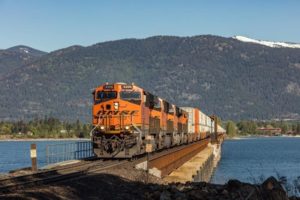 |
"The train whistle, or horn, is an important part of our safety practices," Burlington Northern Sante Fe personnel wrote in the October edition of the BNSF Inside Track. "The horn alerts people that a train is approaching a railroad crossing. It can also be used to warn animals or trespassers in our right-of-way along a section of track. Many people don't realize that federal and state regulations require us to sound the horn whenever we approach any crossing."
Under the federal Train Horn Rule (49 CFR Part 222), locomotive engineers must begin to sound train horns at least 15 seconds, and no more than 20 seconds, in advance of all public grade crossings.
If a train is traveling faster than 60 mph, engineers will not sound the horn until it is within one quarter of a mile of the crossing, even if the advance warning is less than 15 seconds.
There is a "good faith" exception for locations where engineers can’t precisely estimate their arrival at a crossing and begin to sound the horn no more than 25 seconds before arriving at the crossing.
Train horns must be sounded in a standardized pattern of two long, one short and one long blasts. The pattern must be repeated or prolonged until the lead locomotive or lead cab car occupies the grade crossing. The rule does not stipulate the durations of long and short blasts.
The maximum volume level for the train horn is 110 decibels, which is a new requirement. The minimum sound level remains 96 decibels.
The final rule also provides an opportunity for localities nationwide to mitigate the effects of train horn noise by establishing “new quiet zones.”
“No horn” restrictions which may have existed prior to the establishment of the rule may be qualified to be “pre-rule quiet zones.”
In a quiet zone, railroads have been directed to cease the routine sounding their horns when approaching public highway-rail grade crossings. Train horns may still be used in emergency situations or to comply with other Federal regulations or railroad operating rules.
Localities desiring to establish a quiet zone are first required to mitigate the increased risk caused by the absence of a horn.
Learn how to create a Quiet Zone here. Additional resources on Quiet Zones can be found here.